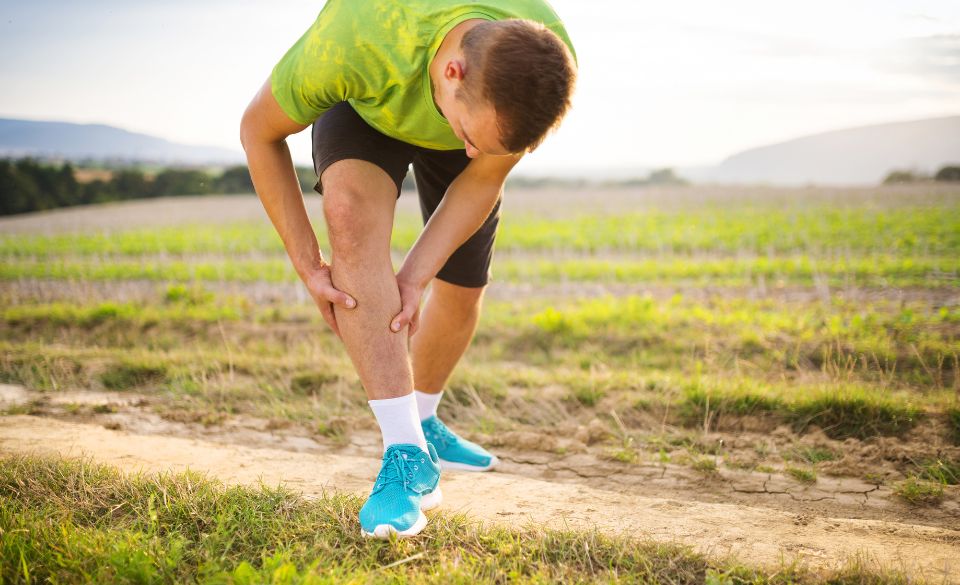
Should You Run If Your Legs Are Sore?
Page Contents
- Does Lactic Acid Cause Muscle Soreness?
- What Causes Sore Muscles From Running?
- Should You Run If Your Legs Are Sore?
- Can A Run Help Sore Legs?
- What If You Are Sore All The Time?
- Nutrition To Help Sore Muscles From Running
- Does Foam Rolling Help If Your Legs Are Sore From Running
- Final Words – Should You Run If Your Legs Are Sore?
Naturally, every runner encounters soreness at some point. This soreness can range from mild stiffness to the dreaded difficulty of descending stairs. Undoubtedly, you’ve pondered the question: Should you go for a run when your legs are sore?
Delayed-onset muscle soreness (DOMS) is a term familiar to many. It’s that feeling of soreness that often doesn’t hit you immediately after a workout but sneaks up a day or two later, just when you’re gearing up for your next training session.
Does Lactic Acid Cause Muscle Soreness?
Despite a long-standing myth, the answer is no. Lactate, a by-product of glycolysis during moderate and high-intensity exercise, was once believed to turn into lactic acid, potentially causing muscle soreness if not cleared out. However, our understanding of lactate has evolved. Lactate is efficiently shuttled out of the muscles during exercise and transported to the liver, where some of it is converted back into glucose and sent back to the muscles for energy production through a process known as the Cori cycle. Thus, while some lactate may accumulate during high-intensity exercise, it is not the culprit behind muscle soreness, as it clears from the muscles shortly after exercise cessation.
What Causes Sore Muscles From Running?
Think about the common scenarios when you experience muscle soreness: after a long run, a strength training session, or downhill running. What ties these situations together is that your muscles are subjected to prolonged mechanical load, known as time under tension. This mechanical tension leads to microdamage within the muscle fibers’ contractile units. Additionally, elevated levels of intracellular calcium, a result of repeated muscle contractions, may also cause some damage to contractile proteins. For instance, during a long run, your muscles endure tension for hours on end. In strength training, you apply a higher mechanical load to your muscles, and downhill running involves eccentric muscle actions, concentrating force on smaller cross-sectional muscle areas.
Microdamage within muscle fibers triggers a mild level of inflammation, stimulating pain receptors, which ultimately leads to the sensation of soreness. Moreover, heightened activity in pain receptors contributes to the discomfort. The body also generates more reactive oxygen species in response to inflammation, which can potentially damage surrounding muscle cells.
Exercise-induced muscle damage may occur without soreness. For instance, you can experience muscle damage after running a marathon even if you’re not feeling sore. However, for many runners, muscle damage resulting in DOMS can disrupt their training.
Should You Run If Your Legs Are Sore?
The answer depends on several factors, with the severity of your muscle soreness being a key consideration. If your soreness is mild and doesn’t hinder your ability to move comfortably, you can usually run through it. However, if you find yourself struggling to get out of bed or sit down due to extreme soreness, it’s advisable to grant your body an extra day of rest.
Context matters when it comes to sore legs. If you’re wondering whether to run with sore legs during a training session and the soreness is manageable without significant gait changes, then you can often proceed with your planned workout. However, if your legs are sore following a race, it’s generally better to extend your post-race recovery phase.
Can A Run Help Sore Legs?
Surprisingly, yes. Slow, short runs, often referred to as recovery runs, can reduce the perception of soreness by promoting increased blood flow to your legs. This increased blood flow carries essential nutrients to the damaged muscles, aiding in their recovery. Nevertheless, it’s essential to understand that a recovery run should not replace rest days. Rest days are vital for complete muscle repair, facilitating adaptation, and reducing overall muscle soreness.
What If You Are Sore All The Time?
If you find yourself in a constant state of soreness, it’s worth noting that a well-structured training plan should not leave you perpetually sore. Frequent soreness is indicative of one of two issues, or possibly both: you’re training too intensely, or your nutrition doesn’t support adequate muscle recovery.
Protein intake is particularly crucial for endurance athletes. Dietary protein supplies the necessary building blocks for repairing muscle damage. Without sufficient dietary protein, muscles may not fully recover, leading to accumulating damage and persistent soreness. Depending on your training volume, runners may require anywhere from 1.2 to 2.0 grams of protein per kilogram of body weight. To meet these protein needs, aim to consume 20-40 grams of protein with each meal, along with protein-rich snacks.
Recovery nutrition extends beyond protein; you must consume adequate carbohydrates and total calories as well. A 2023 study published in the Journal of Physiology demonstrated that not consuming enough total calories can impair muscle protein synthesis, resulting in poorer recovery, even with short-term low energy availability. So, even if you’re meeting your protein requirements, insufficient overall calorie intake can contribute to muscle soreness.
Nutrition To Help Sore Muscles From Running
Once you’ve covered the basics—adequate carbohydrates, protein, and overall calories—some supplements may help reduce muscle soreness during intense training periods. Omega-3 fatty acids, vitamin D, and tart cherry juice are three potential supplements to consider.
Vitamin D supplementation may be effective in alleviating DOMS, especially if you’re deficient in this vitamin. Vitamin D plays a role in muscle protein synthesis by activating intracellular receptors, and deficiency can exacerbate muscle damage. A 2020 study in the Journal of the International Society of Sport Nutrition found that vitamin D supplementation reduced biomarkers of muscle damage associated with DOMS after eccentric exercise when serum vitamin D levels were low. However, before supplementing, it’s crucial to have your vitamin D levels checked through bloodwork.
Omega-3 supplements, while still an emerging area of research, may have a role in reducing soreness from running. A 2020 review in Nutrients pointed to the potential of omega-3 fatty acids in enhancing recovery and reducing excess inflammation, ultimately leading to a reduction in DOMS. If you choose to supplement with omega-3, look for a product with at least 2000 mg of EPA and DHA.
Tart cherry juice is another supplement with potential benefits. Research, as shown in a 2021 review in the International Journal of Sport Nutrition and Exercise Metabolism, suggests that tart cherry juice can help mitigate muscle soreness. It’s important to opt for pure tart cherry juice, not sweetened versions.
Does Foam Rolling Help If Your Legs Are Sore From Running
Regarding recovery techniques, foam rolling may not expedite muscle repair, but it can help reduce your perception of soreness. Foam rolling applies gentle pressure to the muscles, potentially altering their neural excitability and reducing the sensation of muscle soreness.
On the other hand, the research on massage guns (percussive therapy) and DOMS is inconclusive. Some studies suggest that percussive massage may reduce muscle soreness, while others do not provide conclusive evidence. Ultimately, your individual response matters, so if foam rolling or a massage gun helps you feel better, use them. However, avoid excessive pressure, as it can increase inflammation and muscle damage, leading to more soreness.
Final Words – Should You Run If Your Legs Are Sore?
In conclusion, if you’re frequently wondering whether you should run when your legs are sore, making a few adjustments to your training and nutrition can go a long way in reducing muscle soreness. Ensuring adequate protein, carbohydrate, and calorie intake, along with proper recovery techniques and potential supplements, can help you manage soreness and optimize your running performance. Additionally, maintaining a well-structured training plan that balances intensity and gradual progression can help prevent chronic soreness. So, while sore legs are an inevitable part of running, they don’t have to be a constant hindrance to your training and enjoyment of the sport.




